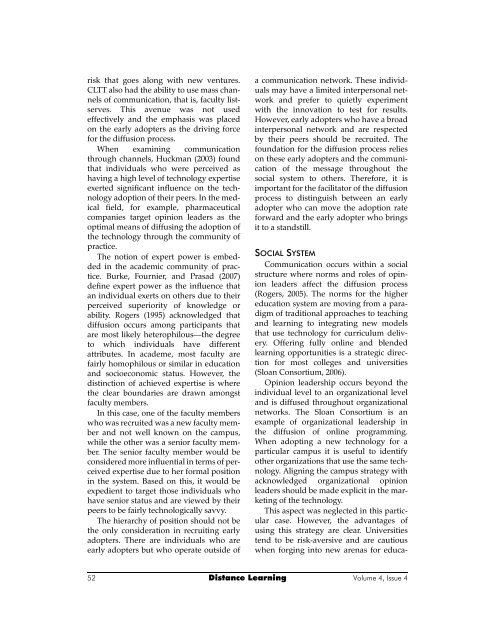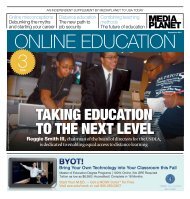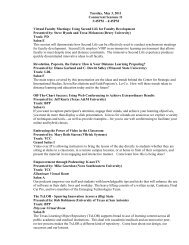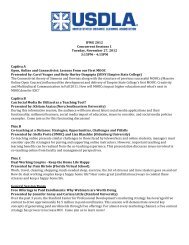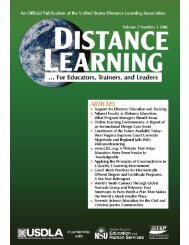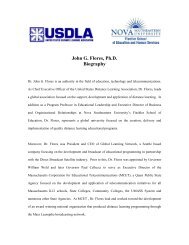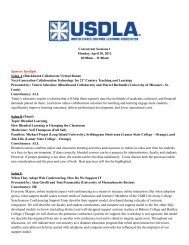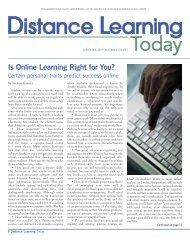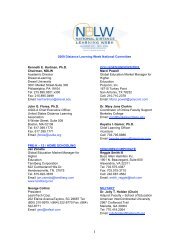United States Distance Learning Association
United States Distance Learning Association
United States Distance Learning Association
- No tags were found...
You also want an ePaper? Increase the reach of your titles
YUMPU automatically turns print PDFs into web optimized ePapers that Google loves.
isk that goes along with new ventures.<br />
CLTT also had the ability to use mass channels<br />
of communication, that is, faculty listserves.<br />
This avenue was not used<br />
effectively and the emphasis was placed<br />
on the early adopters as the driving force<br />
for the diffusion process.<br />
When examining communication<br />
through channels, Huckman (2003) found<br />
that individuals who were perceived as<br />
having a high level of technology expertise<br />
exerted significant influence on the technology<br />
adoption of their peers. In the medical<br />
field, for example, pharmaceutical<br />
companies target opinion leaders as the<br />
optimal means of diffusing the adoption of<br />
the technology through the community of<br />
practice.<br />
The notion of expert power is embedded<br />
in the academic community of practice.<br />
Burke, Fournier, and Prasad (2007)<br />
define expert power as the influence that<br />
an individual exerts on others due to their<br />
perceived superiority of knowledge or<br />
ability. Rogers (1995) acknowledged that<br />
diffusion occurs among participants that<br />
are most likely heterophilous—the degree<br />
to which individuals have different<br />
attributes. In academe, most faculty are<br />
fairly homophilous or similar in education<br />
and socioeconomic status. However, the<br />
distinction of achieved expertise is where<br />
the clear boundaries are drawn amongst<br />
faculty members.<br />
In this case, one of the faculty members<br />
who was recruited was a new faculty member<br />
and not well known on the campus,<br />
while the other was a senior faculty member.<br />
The senior faculty member would be<br />
considered more influential in terms of perceived<br />
expertise due to her formal position<br />
in the system. Based on this, it would be<br />
expedient to target those individuals who<br />
have senior status and are viewed by their<br />
peers to be fairly technologically savvy.<br />
The hierarchy of position should not be<br />
the only consideration in recruiting early<br />
adopters. There are individuals who are<br />
early adopters but who operate outside of<br />
a communication network. These individuals<br />
may have a limited interpersonal network<br />
and prefer to quietly experiment<br />
with the innovation to test for results.<br />
However, early adopters who have a broad<br />
interpersonal network and are respected<br />
by their peers should be recruited. The<br />
foundation for the diffusion process relies<br />
on these early adopters and the communication<br />
of the message throughout the<br />
social system to others. Therefore, it is<br />
important for the facilitator of the diffusion<br />
process to distinguish between an early<br />
adopter who can move the adoption rate<br />
forward and the early adopter who brings<br />
it to a standstill.<br />
SOCIAL SYSTEM<br />
Communication occurs within a social<br />
structure where norms and roles of opinion<br />
leaders affect the diffusion process<br />
(Rogers, 2005). The norms for the higher<br />
education system are moving from a paradigm<br />
of traditional approaches to teaching<br />
and learning to integrating new models<br />
that use technology for curriculum delivery.<br />
Offering fully online and blended<br />
learning opportunities is a strategic direction<br />
for most colleges and universities<br />
(Sloan Consortium, 2006).<br />
Opinion leadership occurs beyond the<br />
individual level to an organizational level<br />
and is diffused throughout organizational<br />
networks. The Sloan Consortium is an<br />
example of organizational leadership in<br />
the diffusion of online programming.<br />
When adopting a new technology for a<br />
particular campus it is useful to identify<br />
other organizations that use the same technology.<br />
Aligning the campus strategy with<br />
acknowledged organizational opinion<br />
leaders should be made explicit in the marketing<br />
of the technology.<br />
This aspect was neglected in this particular<br />
case. However, the advantages of<br />
using this strategy are clear. Universities<br />
tend to be risk-aversive and are cautious<br />
when forging into new arenas for educa-<br />
52 <strong>Distance</strong> <strong>Learning</strong> Volume 4, Issue 4


